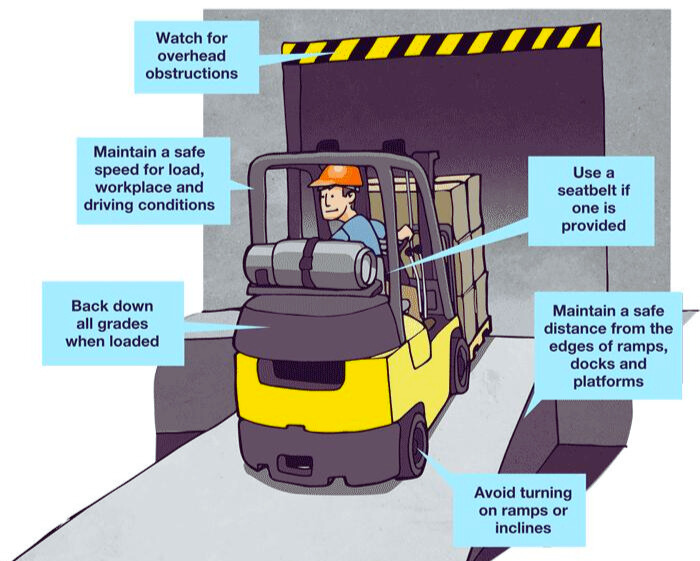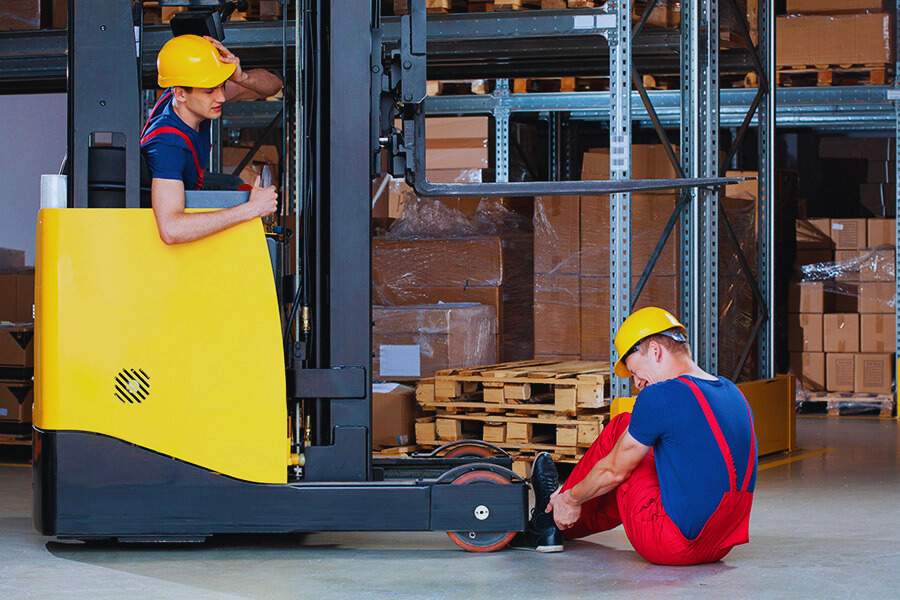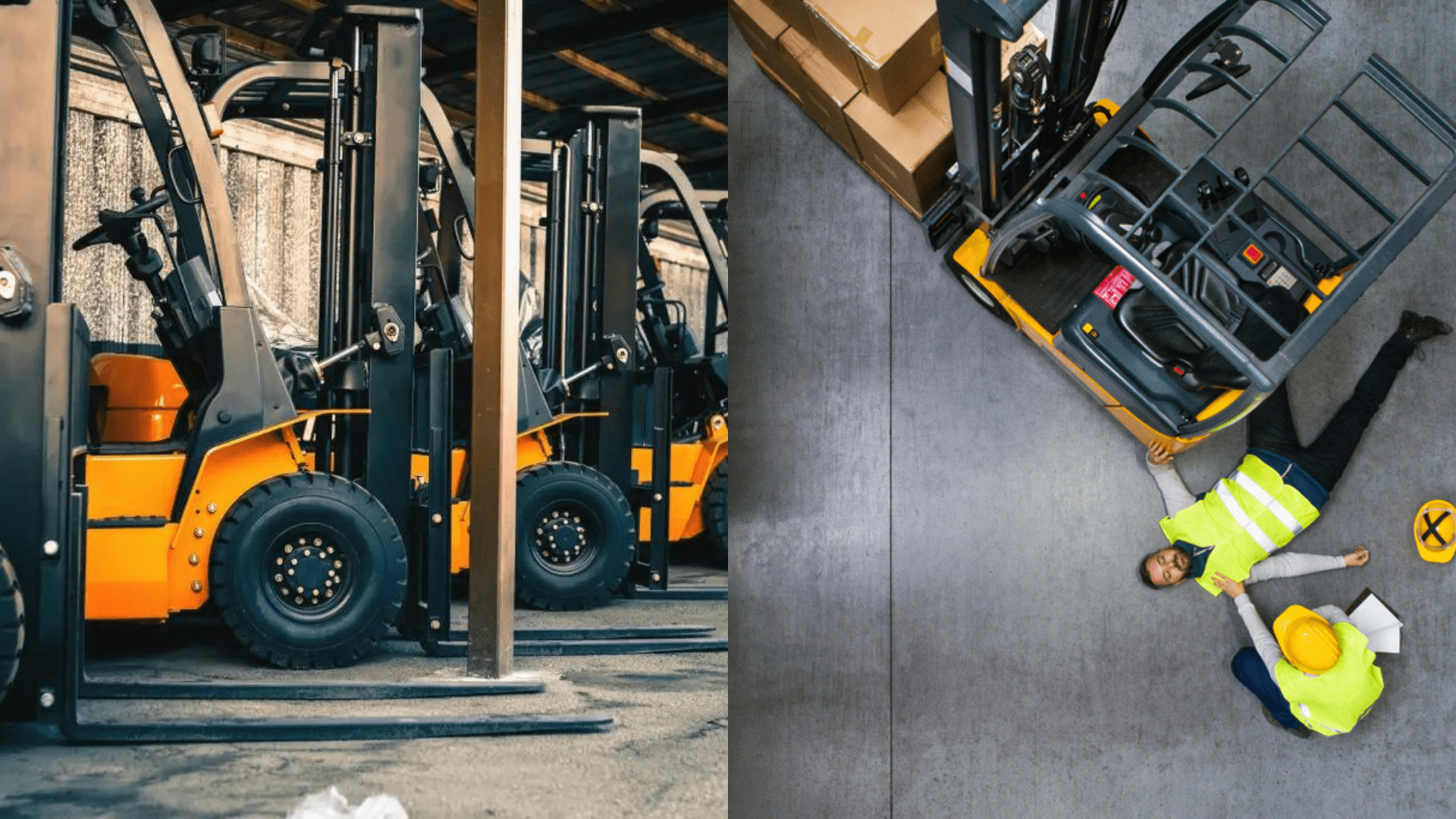The main causes of injuries when using forklifts revolve around operator error, environmental conditions, and mechanical failures. Operator errors can include improper handling, lack of training, or failure to adhere to safety protocols. Environmental conditions that lead to accidents involve cluttered or poorly organized workspaces, inadequate signage or warnings, and hazardous areas like inclines or drop-offs not being properly marked or barricaded. Mechanical failures involve the forklift itself, such as malfunctions due to lack of maintenance or using equipment beyond its capacity. To mitigate these risks, comprehensive training, workplace organization, safety enhancements on equipment, proactive recertification, and clear marking of hazardous areas are essential.
Understanding Forklift Operations

Effective forklift operations require adherence to several safety practices and operational strategies. Key strategies include:
- Separating pedestrians and forklifts, using guards and barriers to prevent accidents.
- Ensuring operators do not raise or lower forks while the forklift is in motion and maintaining a safe speed.
- Obtaining forklift certification, wearing proper clothing, and knowing the specific class of forklift being operated.
- Keeping a safe distance from bystanders and other machinery to avoid collisions.
- Following a strict maintenance and inspection schedule to minimize breakdowns and ensure operational safety.
- Ensuring the load is balanced and fully secure, with forks correctly positioned under the load to prevent tipping.
The Basics of Forklift Use
Operating a forklift involves several key steps and knowledge areas for safe and efficient use:
- Pre-Operation: Before using a forklift, conduct a thorough check of the vehicle, including brakes, steering, controls, and warning devices.
- Basic Operations: Learn how to start the forklift, engage the transmission, and maneuver it. Always wear a seatbelt and follow the correct procedures for mounting and dismounting.
- Traveling: Understand how to safely drive a forklift, including speed control, navigating turns, and avoiding hazards. Be aware of the forklift’s stability triangle and load capacity.
- Load Handling: Master lifting, moving, and placing loads properly to maintain balance and prevent accidents. This includes knowing how to position forks and adjust loads for stability.
- Controls Mastery: Familiarize yourself with the forklift’s controls, including acceleration, braking, and hydraulics for lifting and lowering loads.
Common Types of Forklifts
Forklifts come in various types, each designed for specific applications:
- Counterbalance Forklift: The most common type, featuring forks at the front and a counterweight at the back to balance loads.
- Pallet Jack: Also known as pump trucks, these are used for lifting and moving pallets within warehouses.
- Reach Trucks: Designed for warehouses, these can extend their forks beyond the compartment and lift loads to great heights.
- Telehandlers: Featuring an extendable arm, telehandlers are versatile and can be used in various industries for lifting loads to high places.
- Rough Terrain Forklifts: Built for outdoor use on uneven surfaces, these have large, pneumatic tires.
- Industrial Side Loader Forklifts: Ideal for carrying long loads in narrow aisles, as the forks are mounted on the side of the forklift.
Major Causes of Forklift Injuries

Forklift injuries can occur due to a variety of reasons, with some of the major causes including:
- Lack of Proper Training: The absence of comprehensive forklift training and certification for operators is a leading cause of accidents.
- Speeding: Operating a forklift at high speeds increases the risk of accidents and injuries.
- Driving with an Elevated Load: This can impair visibility and balance, leading to accidents.
- Faulty Equipment: Mechanical failures or not maintaining equipment properly can lead to dangerous incidents.
- Tipping Over: Forklift overturns are a significant cause of fatalities and injuries, often resulting from improper turning or carrying loads that are too heavy.
- Collisions with Pedestrians: Lack of awareness or failure to communicate with people in the vicinity can result in accidents.
- Falling Loads: Improperly secured or overbalanced loads can fall, causing injuries to operators and bystanders.
Operator Error
Operator errors in forklift operations can lead to accidents and injuries. Common mistakes include:
- Not being aware of surroundings can lead to collisions and other accidents.
- Failing to ask for help when needed can result in unsafe handling of loads or navigation in tight spaces.
- Skipping thorough inspections at the start of shifts can mean missing critical issues with the forklift or the environment.
- Improper load positioning on the forks makes the forklift unstable and increases the risk of dropping loads.
- Speeding and breaking safety rules, including reckless behavior that compromises safety.
- Neglecting regular forklift inspections, such as not checking tire pressure, wear and tear, and potential workspace obstructions.
Lack of Training
Lack of training in forklift operation significantly increases the risk of workplace accidents. Key issues associated with insufficient forklift training include:
- Increased Accident Rates: Proper training can drastically reduce workplace accidents by ensuring operators understand how to navigate and manage forklifts safely.
- Legal Consequences: Operating without a forklift certification can lead to prosecutions for companies or individuals by health and safety authorities.
- Unsafe Practices: Lack of training results in bad habits like unsafe loading, neglecting safety checklists, speeding, and loss of awareness, all of which contribute to higher accident risks.
- Worksite Hazards: Careless equipment handling due to poor operation practices creates significant safety hazards.
- Inadequate Training Impact: Around 25% of forklift accidents are attributed to improper or inadequate operator training, highlighting the need for enhanced training protocols.
- Environmental and Safety Impacts: Trained operators are also less likely to spill hazardous materials or contribute to air pollution, underlining the broader implications of proper forklift training.
Speeding
Speeding with forklifts significantly increases the risk of accidents due to reduced control and stability, especially when carrying heavy loads or navigating in tight spaces. Safe stopping distances, which are crucial for preventing collisions, are directly affected by the forklift’s speed. Factors such as load weight, operator experience, and environmental conditions can influence the appropriate speed for safe operation. Despite speed being a factor in forklift accidents, issues like visibility often play a more significant role. However, both forklift speed and inadequate training are leading causes of accidents, underscoring the importance of comprehensive operator training and adherence to safe speed guidelines.
Improper Turning Techniques
Improper turning techniques while operating a forklift can lead to accidents, including overturning and collisions. Common mistakes include carrying loads at dangerous heights during movement, which increases the risk of overturning, and incorrect load placement on the forks, either too far forward or too far back, compromising the forklift’s stability. To avoid these mistakes, operators should ensure loads are secure and at a safe height while turning and pay careful attention to load placement on the forks for optimal balance.
Mechanical Failures
Common forklift mechanical failures include low levels of steering fluid transmission, worn-out gears causing steering issues, mast or lift problems, faulty steering, engine overheating, and worn-out tyres and suspension. Starting issues are also prevalent, alongside sluggish or unresponsive hydraulics. Mechanical failure often results from improper operation or lack of maintenance, highlighting the importance of regular checks and proper handling to prevent such issues.
Lack of Regular Maintenance
Ignoring regular maintenance of forklifts can lead to several significant issues:
- Increased risk of accidents, potentially resulting in injuries, lawsuits, or workers’ compensation claims.
- Reduced efficiency of the equipment, which can affect overall productivity.
- Increased downtime and the potential for major, costly repairs due to improper maintenance.
- Decreased performance and efficiency, as regular maintenance ensures optimal levels of operation.
- Avoidance of major failures in the future, emphasizing the importance of maintenance to reduce costs.
- Prevention of catastrophic failures like brake failure, which could lead to deadly accidents or indefinitely sideline the lift truck.
Faulty Parts
Forklifts can experience various common issues due to faulty parts, including:
- Hose Damage and Leaks – Hydraulic hoses can be damaged, leading to leaks that affect the forklift’s operation.
- Mast Failure – Problems with the mast, such as failure to lift or lower correctly, are common and can severely impact a forklift’s functionality.
- Damaged Safety Accessories – Safety accessories like lights, alarms, and mirrors can be damaged, compromising the safety of the forklift operator and others nearby.
- Startup Issues – Starting problems can arise due to various reasons, including the forklift running out of fuel or electrical issues.
- Engine Problems – Engine-related issues are also among the most common problems, affecting the forklift’s performance and reliability.
Addressing these issues promptly through regular maintenance and repairs is crucial to prevent downtime and ensure the forklift’s longevity and safety.
Workplace Environment Issues
Workplace environment issues impacting forklift safety can be mitigated through various strategies:
- Awareness of Blind Spots: Training forklift operators and pedestrians about the vehicle’s blind spots to prevent accidents.
- Safety Training: Implement comprehensive safety training programs for all warehouse staff to understand and respect forklift operations.
- Ergonomic Solutions: Adopting ergonomic solutions, such as choosing forklifts with low step-in heights and reducing vibration, can enhance operator comfort and safety.
- Compliance with OSHA Standards: Ensuring adherence to OSHA standards through regular inspections and safety protocols is crucial for maintaining a safe working environment.
- Improving Safety in Adverse Conditions: Training for forklift operation in adverse conditions, like wet or uneven floors, to prevent accidents.
- Forklift Proximity Warning Systems: Investing in advanced safety technologies, such as proximity warning systems, to alert drivers and pedestrians of potential hazards.
Addressing these workplace environment issues through proactive measures can significantly enhance forklift safety and overall workplace safety.
Poorly Designed Workspaces
Poorly designed workspaces significantly contribute to forklift accidents and inefficiencies in operations. Key issues include:
- Congested Work Areas: Congestion makes maneuvering forklifts difficult, increasing the risk of accidents.
- Inadequate Training: The root cause of nearly 70% of workplace accidents is attributed to poorly trained or inexperienced forklift operators.
- Driver Error and Safety Design: Accidents can also stem from driver error and the poor safety design of forklifts.
- Work Organization Factors: Production pressures, such as speed and stress, along with the lack of proper tools and attachments, contribute to forklift incidents.
- Ergonomic Issues: An ergonomic design is crucial not only for physical comfort but also for reducing workplace stress, which can indirectly affect safety and efficiency.
Improving workspace design by addressing these issues can significantly enhance forklift safety and operational efficiency.
Inadequate Signage
Inadequate signage in the workplace, particularly in areas with forklift operations, can significantly increase the risk of accidents. Effective and clear signage serves several critical safety functions:
- Accident Prevention: Proper signage can limit accidents by warning both operators and pedestrians of potential dangers, such as blind corners or areas with high pedestrian traffic.
- Enhanced Visibility: In areas with high traffic, visible markings and signs alert individuals to the presence of forklifts and other hazards, contributing to overall safety.
- Minimizing Hazards: Workplaces with clear and effective signage can minimize hazards, reducing the likelihood of work injuries. Conversely, improper or insufficient signage can lead to serious accidents.
Implementing adequate signage is a fundamental aspect of workplace safety management, crucial for preventing forklift accidents and ensuring a safe environment for all employees.
Preventive Measures
Preventive measures to reduce human error and improve safety in workplaces and driving can include:
- Identifying Prone Areas: Recognize where human error is most likely to occur and focus efforts on these areas.
- System Implementation: Develop and implement systems designed to minimize the risk of human error, such as automated checks or fail-safes.
- Use of Checklists: Deploy checklists to ensure all necessary steps are followed and nothing is overlooked.
- Utilizing Technology: Leverage technology to recognize and correct issues before they occur, especially in manufacturing environments.
- Training: Offer comprehensive training addressing skill deficiencies and compliance to ensure all employees are competent and aware of best practices.
- Speeding and Aggression Control: Implement measures to combat speeding and aggressive driving, including education and enforcement strategies.
Training and Certification
Training and certification in health and safety are crucial for maintaining a safe work environment. For 2024, focus areas include:
- Staying Informed and Compliant: Keeping up with the latest safety regulations and ensuring compliance is essential.
- Continuous Learning: Investing in ongoing education and training programs to keep skills up-to-date.
- Prioritizing Employee Training: Ensuring all team members receive proper safety training to perform their jobs safely.
- Implementing Knowledge Assessments: Regularly testing employee knowledge to ensure understanding and application of safety practices.
- Evaluating Skills and Support: Analyzing the skills most valued and how to better support the team in learning and training.
- Comprehensive Overview of Regulations and Standards: Offering courses that cover occupational health and safety regulations, standards, and best practices.
- Focusing on Workplace Safety: Highlighting the importance of workplace safety through courses on OSHA guidelines and hazard communication.
Regular Maintenance and Inspections
Regular maintenance and inspections are crucial for vehicle safety, ensuring they operate properly and safely. Key practices include:
- Conducting Pre-Use Inspections: Vehicles should be inspected before first use on work shifts to identify any potential issues.
- Maintaining Regularly: Proper maintenance is essential to keep vehicles in safe working condition, and any defects found must be corrected promptly.
- Safety Precautions: When maintaining vehicles, safety precautions such as applying brakes, chocking wheels, and ensuring the vehicle is in neutral gear with brakes on should be taken.
- Utilizing Digital Solutions: Digital solutions like SafetyCulture can streamline the process of vehicle inspections, making it easier to maintain roadworthiness.
- Recording and Reviewing Defects: Any issues or defects found during operation, inspection, or maintenance should be thoroughly recorded and reviewed to ensure safety.
Workplace Safety Practices
To ensure a safe workplace in 2024, consider these key practices drawn from the latest industry insights:
- Communicate the Importance of Safety Culture: Make safety the top priority, emphasizing its value across the organization.
- Encourage Situational Awareness: Train employees to be aware of their environment and potential hazards.
- Host Regular Safety Training: Keep safety knowledge up-to-date with ongoing training sessions.
- Utilize Protective Equipment: Ensure employees use the necessary protective gear for their tasks.
- Maintain a Clean Workstation: Encourage regular cleaning and organization to prevent accidents.
- Take Appropriate Breaks: Breaks can help prevent fatigue and maintain focus, contributing to a safer work environment.
- Follow Safety Protocols: Adherence to established safety procedures is crucial for minimizing risks.
- If You See Something, Say Something: Foster a culture where employees feel empowered to report safety concerns.
Conclusion
The consequences of forklift-related injuries can be severe, impacting lives and livelihoods. However, with proper understanding, training, and safety measures in place, these incidents can be significantly reduced. It’s about creating a culture of safety where everyone plays their part in ensuring a safe working environment.
Read also: How Many Grammys Does Beyoncé Have?




